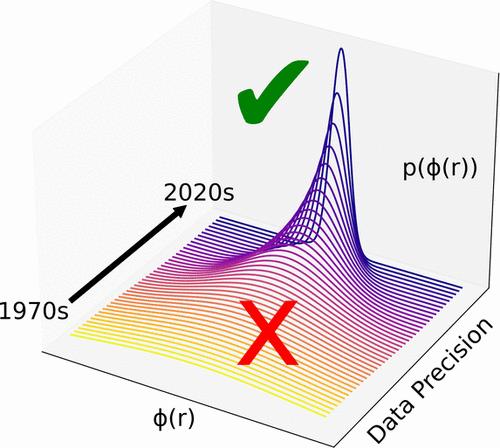贝叶斯分析揭示了从中子散射数据中提取对势的关键
IF 4.6
2区 化学
Q2 CHEMISTRY, PHYSICAL
引用次数: 0
摘要
由于中子和 X 射线散射实验的精度限制,从结构因子中学习相互作用势通常被认为是不切实际的。本研究在米氏流体上使用贝叶斯推理和概率机器学习重新审视了这一历史性的反问题,以阐明测量噪声如何影响恢复电势的准确性。为了进行可靠的电位重建,我们建议散射数据在标准仓宽度为 0.05 Å-1 时,其噪声必须小于 0.005,最大可达 30 Å-1。当不确定度低于这个阈值时,米氏势的斥力指数可在大约 ±1.3 的范围内确定,原子尺寸可在 ±0.068 Å 的范围内确定,井深可在 ±0.024 kcal/mol 的范围内确定,置信度为 95%。这些发现凸显了将散射和机器学习结合起来以攻克一个具有百年历史的物理难题、推断局部原子力以作为模型验证的重要基准以及提高分子模拟准确性的潜力。本文章由计算机程序翻译,如有差异,请以英文原文为准。

Bayesian Analysis Reveals the Key to Extracting Pair Potentials from Neutron Scattering Data
Learning interaction potentials from the structure factor is frequently seen as impractical due to accuracy constraints of neutron and X-ray scattering experiments. This study reexamines this historic inverse problem using Bayesian inference and probabilistic machine learning on a Mie fluid to elucidate how measurement noise impacts the accuracy of recovered potentials. To perform reliable potential reconstruction, we recommend that scattering data must have noise smaller than 0.005 up to ∼30 Å–1 at a standard bin width 0.05 Å–1. At uncertainties below this threshold, Mie potentials can be determined within approximately ±1.3 for the repulsive exponent, ±0.068 Å for atomic size, and ±0.024 kcal/mol in well-depth with 95% confidence. These findings highlight the potential of uniting scattering and machine learning to overcome a century-old physics problem, infer local atomic forces to serve as a vital benchmark for model validation, and enhance the accuracy of molecular simulations.
求助全文
通过发布文献求助,成功后即可免费获取论文全文。
去求助
来源期刊

The Journal of Physical Chemistry Letters
CHEMISTRY, PHYSICAL-NANOSCIENCE & NANOTECHNOLOGY
CiteScore
9.60
自引率
7.00%
发文量
1519
审稿时长
1.6 months
期刊介绍:
The Journal of Physical Chemistry (JPC) Letters is devoted to reporting new and original experimental and theoretical basic research of interest to physical chemists, biophysical chemists, chemical physicists, physicists, material scientists, and engineers. An important criterion for acceptance is that the paper reports a significant scientific advance and/or physical insight such that rapid publication is essential. Two issues of JPC Letters are published each month.
 求助内容:
求助内容: 应助结果提醒方式:
应助结果提醒方式:


